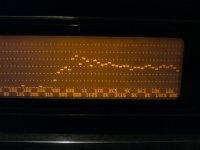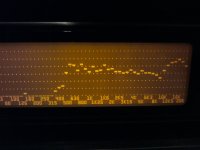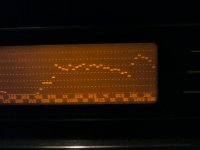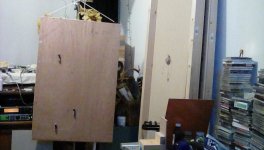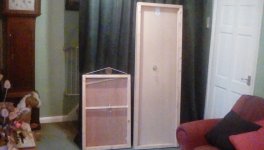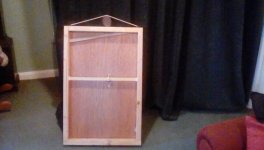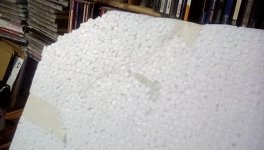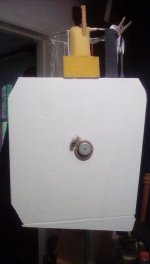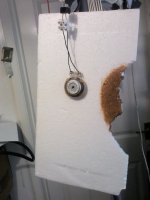Burntcoil.
I was going to take the tape off my 2ftx3ft rigidly Framed 3mm ply panels and start again but decided to take these interesting photos.
The first photo on the left was at just over 1ft in front of the exciter area with tape and small piece of blu-tack still in place.
The second photo was at the same distance but at the bottom right of the panel ,the HF holds up all over the panel unchanged it's doing its own thing.
The third ,just to make the point ,was with the microphone lying on the floor 5ft to the left of the panel!!!
The HF still holding up , almost identical.
The response from the central area in the first photo is acting like a separate drive unit .
The panel response itself has changed little in the second photo.
As proved by the third photo which is away directly to the left of the panel on the floor!!
The dml rigid Framed ply panel is radiating full frequencies in all directions down to below 40hz (not shown).
DML ,would you Adam and Eve it.
I love them.
Steve
I was going to take the tape off my 2ftx3ft rigidly Framed 3mm ply panels and start again but decided to take these interesting photos.
The first photo on the left was at just over 1ft in front of the exciter area with tape and small piece of blu-tack still in place.
The second photo was at the same distance but at the bottom right of the panel ,the HF holds up all over the panel unchanged it's doing its own thing.
The third ,just to make the point ,was with the microphone lying on the floor 5ft to the left of the panel!!!
The HF still holding up , almost identical.
The response from the central area in the first photo is acting like a separate drive unit .
The panel response itself has changed little in the second photo.
As proved by the third photo which is away directly to the left of the panel on the floor!!
The dml rigid Framed ply panel is radiating full frequencies in all directions down to below 40hz (not shown).
DML ,would you Adam and Eve it.
I love them.
Steve
Attachments
Raph.
If you want to do short term testing of different panels, the method I used was to use masking tape to support the weight of the exciter magnet , suspended from the top edge of the panel.
You could use any bog standard roll of double sided tape to hold the coil to the panel short term ,I also used foam on the masking tape to stop LF buzzing noises,if using down that low.
Not sure of the weight of this exciter but the lower grades of eps would have problems supporting the weight of an unsupported exciter, literally ripping the polystyrene off of the panel.
And have some sort padding on the floor should the exciter falls.
Of course you could use the lead out wires to support the weight of the exciter.
This is what I used to do as I was always swapping panels,but my exciters only weighed 85grm.
Steve
@Steve
Thank you for your reply. gonna get some masking tape from my local DIY store today, mess around with it and combine it with some foam.
I have the DAEX30HESF-4 exciter and compared to yours its super heavy at around 140g!!!, meaning I have to give it some grade A support because of shortages in the EU (I think I bought the last one of Amazon.co.uk and had it sent to Poland 😉 ).
Obviously another problem is the EPS. Most of the specialised shops are closed so I'm gonna be messing around with cotton and linen paintings as the local stores are open for a few hrs every day here in Warsaw 🙂 . Linen frames are supposed to be sturdier than the cotton ones.
If anyone will be interested in the results I'll be more than happy to share them.
Raf
Raf.
If you look at my post 1854,on page 186,you will see this small cc panel, this took no more than 5 minutes to put together,and was free and will be easy to to dispose of.
If the weight of the panel is lighter than the exciter ,you can let it hang as I do ,or mount the exciter on a pole ,or even hang the exciter and panel separately.
If you want to test lots of different panel materials it's far easier using small panels.
Having lots of 2ft4ft panels lying around is no joke ,and if purchased can be very expensive.
Of course if you are trying to produce a full range panel because you have no xo or LF unit ,then that's a problem.
My rigidly mounted ply panel is cheap if sourced from local diy stores ,and is pretty much full range ,as long as your not into very loud disco music!!
I have lots of polystyrene pizza bases lying around (i don't think they use polystyrene any more),they were free and very useful for testing,but I did put on some weight!!
I have found that my free panels sound just as good as any purchased panels.
Where there is a will, there is a way.
Steve
If you look at my post 1854,on page 186,you will see this small cc panel, this took no more than 5 minutes to put together,and was free and will be easy to to dispose of.
If the weight of the panel is lighter than the exciter ,you can let it hang as I do ,or mount the exciter on a pole ,or even hang the exciter and panel separately.
If you want to test lots of different panel materials it's far easier using small panels.
Having lots of 2ft4ft panels lying around is no joke ,and if purchased can be very expensive.
Of course if you are trying to produce a full range panel because you have no xo or LF unit ,then that's a problem.
My rigidly mounted ply panel is cheap if sourced from local diy stores ,and is pretty much full range ,as long as your not into very loud disco music!!
I have lots of polystyrene pizza bases lying around (i don't think they use polystyrene any more),they were free and very useful for testing,but I did put on some weight!!
I have found that my free panels sound just as good as any purchased panels.
Where there is a will, there is a way.
Steve
I like unconventional speakers, so when I saw this thread I felt like I had to try. After some communication with BurntCoil (thanks!) I ended up with a 120x60 cm panel from 4 mm pine plywood. I had it stained as I was staining other stuff at the moment (broom sticks for my daughters Harry Potter party):
View attachment 838425
I tried moving the exciter (Dayton DAEX32EP) around, but didn't hear any obvious differences, so I just chose a slightly off-center position and removed the protective strip from the adhesive. The panel is clamped at the bottom between two 45x70 mm studs (is that the correct word?) with some EPDM strips in between.
The sound is really nice with acoustic music, although it does lack the top octave (sizzle from cymbals and s-sounds from vocals). For electronic music and rock I feel they are a bit to "slow", i.e. the sounds are too long. I'm surprised that the panels reach so low. Here is the raw response (indoors):
View attachment 838426
If the weather allows it I'll make some outdoor measurements tomorrow.
Any hints on how to increase output above 10 kHz? Secondary small panel where the exciter is mounted? Treatment of plywood (lacquer)?
/Anton
I have used clamps in exactly the same way as you,only I don't use foam.
This is the back of my rigidly mounted 3ftx2ft 3mm ply panel ,you can see my pretty feeble attempt at using a panel brace across the top left corner to break up panel standing waves,should be a lot more substantial but it worked.
I should not have used the spine to support the exciter, ply panels tend to wourp badly.
A good way to spot standing waves is to play music with loads of low drumming like Japanese drummers or similar.
You then press pause ,if there is even a short shrooom sound after the music stops,you have the problem,the panel is carrying on resonating like a drum.
As for hf ,if you can get the hf into the ply panel it is more than capable of reaching 20k and beyond.
I did make a tweeter out of a treated beer mat once to replace the paper strip.
I was a bit surprised when it reached down to 500 or 600hz ,only a few hundred hz short of what I was xo the large panels ,some tweeter.
Steve
Attachments
Raph.
If you want to do short term testing of different panels, the method I used was to use masking tape to support the weight of the exciter magnet , suspended from the top edge of the panel.
You could use any bog standard roll of double sided tape to hold the coil to the panel short term ,I also used foam on the masking tape to stop LF buzzing noises,if using down that low.
Not sure of the weight of this exciter but the lower grades of eps would have problems supporting the weight of an unsupported exciter, literally ripping the polystyrene off of the panel.
And have some sort padding on the floor should the exciter falls.
Of course you could use the lead out wires to support the weight of the exciter.
This is what I used to do as I was always swapping panels,but my exciters only weighed 85grm.
Steve
I've used long pipe cleaner material to support the drivers weight. From the upper edge to the driver, Not like string, being it doesn't stretch and any resonances will be somewhat suppressed with the material wrapped in the wires. With some creative placement, this works rather well..
A couple questions for those of you that have worked with EPS panels...especially you XRK!
1. What glue is best when try to glue pieces of EPS together? I only have yellow "wood" glue (PVA) currently at home but not sure if that would work well glueing EPS together.
2. Is it possible to use the same glue to hold the exciter onto the EPS panel? and if so would it be better to first lay down a thin coating of pva where the exciter will be mounted, before mounting?
THanks guys!
Geosand
1. What glue is best when try to glue pieces of EPS together? I only have yellow "wood" glue (PVA) currently at home but not sure if that would work well glueing EPS together.
2. Is it possible to use the same glue to hold the exciter onto the EPS panel? and if so would it be better to first lay down a thin coating of pva where the exciter will be mounted, before mounting?
THanks guys!
Geosand
Geo, for gluing EPS together, have you seen the test by this gal? YouTubeA couple questions for those of you that have worked with EPS panels...especially you XRK!
1. What glue is best when try to glue pieces of EPS together? I only have yellow "wood" glue (PVA) currently at home but not sure if that would work well glueing EPS together.
2. Is it possible to use the same glue to hold the exciter onto the EPS panel? and if so would it be better to first lay down a thin coating of pva where the exciter will be mounted, before mounting?
THanks guys!
Geosand
Glidden Gripper primer was the winner.
A couple questions for those of you that have worked with EPS panels...especially you XRK!
1. What glue is best when try to glue pieces of EPS together? I only have yellow "wood" glue (PVA) currently at home but not sure if that would work well glueing EPS together.
Geosand
Just curious, but what makes you want to glue pieces of eps together?
Eric
Are standing waves good? or bad? Azima patents suggest that more natural frequencies (i.e.standing waves or resonances) are better. But we often hear about ways to reduce standing waves/resonances. Angled edges, rounded corners, etc. Are resonances dreaded? or desired? As far as I know, angled perimeters and rounded corners do shift the resonant frequencies of a panel, but do they actually increase or reduce their number, or otherwise improve the performance of a dml? All I know for sure is that my head hurts! Is it COVID, or is is it dml disease?
Veleric.
That is a very good question,one that was explained very well in a patent I found,alas somehow it got deleted from my computer? And for the life of me ,I can not find it again!!!
It showed different shapes of panel and the affects this had on the various peaks and troughs ,and went on to show the ear shaped type panels ,which has minimal parallel sides.
My easy to read take on it is.
Yes dml works by trying to spread standing waves evenly across the panel to produce sound.
But a panel will always have it's own standing waves(resonance),and when these are excited will cause large peaks and troughs.
Some use weights to fill in the deep suck outs ,altering the panel resonances.
some use Panel damping to tame the peaks.
But these will probably have knock on affects.
Having none parallel sides will help prevent the constant bouncing of this resonance back and forth ,breaking it up so to speak.
Anyone with very large panels can hear the very low resonances on their panels just by banging them with your hand,the drumming affect,smaller panels obviously not have such a long sustained resonance.
From what I have heard ,the none paralleled sides might even help the even distribution of ,for want of better words,good dml sounds.
It is well known that square or round panels with the exciter in the centre are the worst offenders for bad resonances ,but that doesn't seem to stop people doing it.
I really wish I had not lost that patent!!
Steve
That is a very good question,one that was explained very well in a patent I found,alas somehow it got deleted from my computer? And for the life of me ,I can not find it again!!!
It showed different shapes of panel and the affects this had on the various peaks and troughs ,and went on to show the ear shaped type panels ,which has minimal parallel sides.
My easy to read take on it is.
Yes dml works by trying to spread standing waves evenly across the panel to produce sound.
But a panel will always have it's own standing waves(resonance),and when these are excited will cause large peaks and troughs.
Some use weights to fill in the deep suck outs ,altering the panel resonances.
some use Panel damping to tame the peaks.
But these will probably have knock on affects.
Having none parallel sides will help prevent the constant bouncing of this resonance back and forth ,breaking it up so to speak.
Anyone with very large panels can hear the very low resonances on their panels just by banging them with your hand,the drumming affect,smaller panels obviously not have such a long sustained resonance.
From what I have heard ,the none paralleled sides might even help the even distribution of ,for want of better words,good dml sounds.
It is well known that square or round panels with the exciter in the centre are the worst offenders for bad resonances ,but that doesn't seem to stop people doing it.
I really wish I had not lost that patent!!
Steve
To me.
Thinking of it ,even with the last patent I was talking of,there is always the problem of the tests done on a certain panel,shape,weight,density,size,exciter,mounting,exiter position,you name it,that basically does not exist anymore ,we will never be able to produce exactly the same results using a similar panel ,exciter ,etc,etc,
Every new panel,exciter,size,and whatever we do to it, will have it's own set of rules,so it is very hard for us to predict any results.
Trial and error ,and watching in real time ,what is happening on the panel has been a long learning curve over the years for me,but it has given me an idea of what works and what doesn't,but it can still surprise.
Annoyingly with patents ,they without fail,seem to use inferior materials,methods ,exciters ,damping ,etc.which I know is going to sound bad,but the patent is great because it does this and that and measures well.
In other words the operation was a success but the patient died.
Anyway,getting a bit carried away now.
Patents,should always be taken with a bit of salt.
Your ears are the real test.
Steve
Thinking of it ,even with the last patent I was talking of,there is always the problem of the tests done on a certain panel,shape,weight,density,size,exciter,mounting,exiter position,you name it,that basically does not exist anymore ,we will never be able to produce exactly the same results using a similar panel ,exciter ,etc,etc,
Every new panel,exciter,size,and whatever we do to it, will have it's own set of rules,so it is very hard for us to predict any results.
Trial and error ,and watching in real time ,what is happening on the panel has been a long learning curve over the years for me,but it has given me an idea of what works and what doesn't,but it can still surprise.
Annoyingly with patents ,they without fail,seem to use inferior materials,methods ,exciters ,damping ,etc.which I know is going to sound bad,but the patent is great because it does this and that and measures well.
In other words the operation was a success but the patient died.
Anyway,getting a bit carried away now.
Patents,should always be taken with a bit of salt.
Your ears are the real test.
Steve
Just curious, but what makes you want to glue pieces of eps together?
Eric
Patent claims...lol
Really, I'm just building a panel with EPS and wanted to use further EPS pieces as both braces and to form a stand amongt other ideas... Of course I want the glue seam to be solid (not rubbery or flexible). Think tall thin panel...
I know XRK is the foam speaker king with lots of experience gluing and cutting foam, so was hoping he had some good ideas.
I watched the video suggested as well as a few others but they all seemed to be using XPS rather than EPS. Upon more searching I found a couple videos on EPS glueing and one recommended plain old pva or carpenter glue and the other recommended some exotic/expense stuff I never heard of and said don't use pva...typical of youtube. So I posted here to hear from the real experts 🙂
geosand
Really, I'm just building a panel with EPS and wanted to use further EPS pieces as both braces and to form a stand amongt other ideas...
Oh, I see. I was thinking you wanted to make a panel bigger or thicker, but EPS is not hard to get in pretty big pieces, so I didn't understand why you would need to glue it.
Eric
Any glue that does not dissolve the EPS is fine: PVA/kids/hobby glue.
Watch out with spray (PU) glue, as the aerosol can melt the EPS. If you hold the can further away or in higher temperatures (warm the can in warm water), and you will be ok.
Spray foam can also be used but is not want you want here, but is i.e. nice for aquarium backgrounds.
I would make stands out of pvc pipe, 2 corners and 4 t-pieces. No need for special pvc glue either as it won't have to hold water. Without glue they will probably hold on fine and you can adjust/resize the stands later or use the pvc for something else. You can get pvc in grey and white and is easy to paint.
Watch out with spray (PU) glue, as the aerosol can melt the EPS. If you hold the can further away or in higher temperatures (warm the can in warm water), and you will be ok.
Spray foam can also be used but is not want you want here, but is i.e. nice for aquarium backgrounds.
I would make stands out of pvc pipe, 2 corners and 4 t-pieces. No need for special pvc glue either as it won't have to hold water. Without glue they will probably hold on fine and you can adjust/resize the stands later or use the pvc for something else. You can get pvc in grey and white and is easy to paint.
Last edited:
Strangely ,I am doing some glueing.
This is a very low density eps panel I'm repairing ,the dog strikes again!
I use my 50x50 mix water and pva ,which I will also use to coat the panel.
The first photo is the first part glued and still wet ,the second is all done ,dry and stronger than before.
I might if I remember,weigh the panel before and after coating the whole panel to see the difference.
The third photo is just an old panel that was square until I cut one side off and stuck the removed piece on another side,no wastage and no parallel sides.
Can't remember but as it is hd eps I think I used neat pva.
Long drying time can be a problem for small fiddly jobs ,I've never used it but hot glue is supposed to be good for quick fixes on small area.
I have a glue gun maybe I'll give it a try to see if it melts the eps?
Steve
This is a very low density eps panel I'm repairing ,the dog strikes again!
I use my 50x50 mix water and pva ,which I will also use to coat the panel.
The first photo is the first part glued and still wet ,the second is all done ,dry and stronger than before.
I might if I remember,weigh the panel before and after coating the whole panel to see the difference.
The third photo is just an old panel that was square until I cut one side off and stuck the removed piece on another side,no wastage and no parallel sides.
Can't remember but as it is hd eps I think I used neat pva.
Long drying time can be a problem for small fiddly jobs ,I've never used it but hot glue is supposed to be good for quick fixes on small area.
I have a glue gun maybe I'll give it a try to see if it melts the eps?
Steve
Attachments
Last edited:
Any glue that does not dissolve the EPS is fine: PVA/kids/hobby glue.
Watch out with spray (PU) glue, as the aerosol can melt the EPS. If you hold the can further away or in higher temperatures (warm the can in warm water), and you will be ok.
Spray foam can also be used but is not want you want here, but is i.e. nice for aquarium backgrounds.
I would make stands out of pvc pipe, 2 corners and 4 t-pieces. No need for special pvc glue either as it won't have to hold water. Without glue they will probably hold on fine and you can adjust/resize the stands later or use the pvc for something else. You can get pvc in grey and white and is easy to paint.
Thanks Think...I'll just try out the pva I have...I thought of using PVC, but thats added expense as I have enough EPS to play with. Though its definitely something to consider for a quick, easy frame build.
I'm also thinking a small base shaker firmly attached to a piece of wood and then maybe attaching that to an EPS panel to see if bass can be generated without too much foam flapping...
geosand
Strangely ,I am doing some glueing.
This is a very low density eps panel I'm repairing ,the dog strikes again!
I use my 50x50 mix water and pva ,which I will also use to coat the panel.
The first photo is the first part glued and still wet ,the second is all done ,dry and stronger than before.
I might if I remember,weigh the panel before and after coating the whole panel to see the difference.
The third photo is just an old panel that was square until I cut one side off and stuck the removed piece on another side,no wastage and no parallel sides.
Can't remember but as it is hd eps I think I used neat pva.
Long drying time can be a problem for small fiddly jobs ,I've never used it but hot glue is supposed to be good for quick fixes on small area.
I have a glue gun maybe I'll give it a try to see if it melts the eps?
Steve
Hey Spedge! Thats a really nice corner glue job. You can hardly even see the seam in the pic. Are you just using a sharp box cutter or heated wire cutter to get the smooth edge on EPS?
Oh and since you are repairing a LD EPS panel, can I assume you found some interesting sounds from it that make it a worth while repair job? I'd be interested in your thoughts on the LD EPS...if for nothing else than as a test platform...
oh and would you recommend using a small bit of pva on the panel to form a small area to mount the exciter too, rather than just mounting to the LD EPS (which seems maybe a bit risky due to the flakiness).
Last edited:
Geosand.
This panel was rescued from a skip in a pub car park with others of different sizes (another avenue of pleasure and panels gone for now!)
I haven't touched the panel yet, but here is a damaged panel I used for testing last year with the usable response above 250hz ,the size is about 16x9inches and 1cm thick .
I did heavily modify the front of the panel (bodge job)so not sure what the naked panel response is?
Yes I do like the sounds this panel makes ,very light and delicate sounding,what you would expect from a panel that only weighs a few grams ,with the proviso that all the eps self noise is dealt with,not done on this panel.
You cannot hang a heavy exciter off of this type of panel,it would pull the beads apart, better to hang the panel off of the exciter .
I usually gently scuff the hard surface off of eps to get rid of the eps self noise and apply my 50x50 mix of water and pva.
The very low grades tend not to have the hard surface ,it is very soft ,so I will apply the pva straight on to the panel.
With the higher grades of eps a thicker coating of pva or maybe cascamite (could try this on the low grade)could help protect the panel and improve sound transmission across the panel.
Anyway ,I can hear the the other half calling,with a list!!
Steve
This panel was rescued from a skip in a pub car park with others of different sizes (another avenue of pleasure and panels gone for now!)
I haven't touched the panel yet, but here is a damaged panel I used for testing last year with the usable response above 250hz ,the size is about 16x9inches and 1cm thick .
I did heavily modify the front of the panel (bodge job)so not sure what the naked panel response is?
Yes I do like the sounds this panel makes ,very light and delicate sounding,what you would expect from a panel that only weighs a few grams ,with the proviso that all the eps self noise is dealt with,not done on this panel.
You cannot hang a heavy exciter off of this type of panel,it would pull the beads apart, better to hang the panel off of the exciter .
I usually gently scuff the hard surface off of eps to get rid of the eps self noise and apply my 50x50 mix of water and pva.
The very low grades tend not to have the hard surface ,it is very soft ,so I will apply the pva straight on to the panel.
With the higher grades of eps a thicker coating of pva or maybe cascamite (could try this on the low grade)could help protect the panel and improve sound transmission across the panel.
Anyway ,I can hear the the other half calling,with a list!!
Steve
Attachments
I should have pointed out that the lines are 5db increments ,so good response up to 10k and about 5db down at 15k,and also the distance was about 10ft
One thing I did notice was that there was an at least 10db to 15db drop in level between the exciter area and the top and bottom of the panel.
So it is acting mainly as a point source,I will see if adding 50x50 pva helps spread the dml across the panel,and check the weight increase when totally dry.
Not sure if it is because I've rigidly mounted my ply panel,but the volume across the whole ply panel seems to hold up very well.
I'm not sure how much of this is relevant to this site ,as the only what I would call a real full range panel is my rigid ply panel,which is good ,but which I don't intend to follow up on,and as this is a full range panel study site,I will usually be at odds with panel designs,and materials.
Mmmmmmm?
Steve
One thing I did notice was that there was an at least 10db to 15db drop in level between the exciter area and the top and bottom of the panel.
So it is acting mainly as a point source,I will see if adding 50x50 pva helps spread the dml across the panel,and check the weight increase when totally dry.
Not sure if it is because I've rigidly mounted my ply panel,but the volume across the whole ply panel seems to hold up very well.
I'm not sure how much of this is relevant to this site ,as the only what I would call a real full range panel is my rigid ply panel,which is good ,but which I don't intend to follow up on,and as this is a full range panel study site,I will usually be at odds with panel designs,and materials.
Mmmmmmm?
Steve
- Home
- Loudspeakers
- Full Range
- A Study of DMLs as a Full Range Speaker
